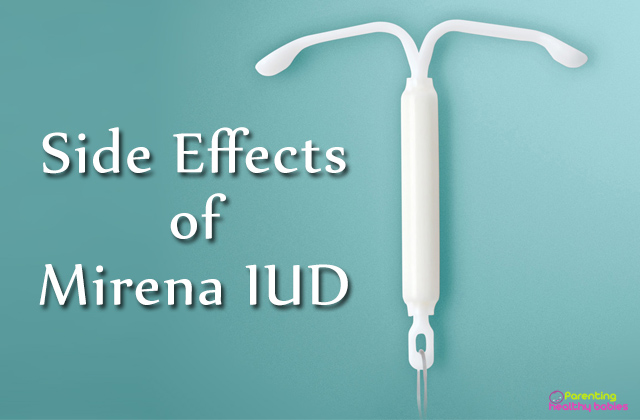Longer periods, shorter periods, nausea, ovarian cysts, mood swings, intense cramps, bloating, pelvic inflammatory disease, pseudotumour cerebri and weight gain are some of the after removal side effects of Mirena IUD.
There are two main types of IUDs: the copper IUD, which uses copper ions to prevent fertilization, and hormonal IUDs, which include Mirena. Mirena works by slowly releasing progestin, a synthetic form of the hormone progesterone, into uterus. The progestin thickens vaginal mucous, thins out uterine lining, and can prevent ovaries from releasing an egg, all of which prevent any sperm from making a baby.
Are you considering getting the Mirena IUD? While this news is great, you should know about few Mirena side effects, in case you are not satisfied with it and plan to remove it. What side effects you experience really depends on how sensitive you are to man-made or synthetic progesterone hormones and that will be different from woman to woman. Below are the following side effects in a list.
Read More: 11 Side Effects of IUD
11 Must Know Side Effects of Mirena IUD After Removal
Shorter periods
In most cases, your period will become significantly lighter and shorter; for 20 percent of women, it will disappear all together. The Mirena was designed to give you a lighter or non-existent period, which is a welcomed side effect for many women. In some cases, removal also results in shorter periods.
Longer periods
A small percentage of women removing the Mirena have persistent irregular bleeding or spotting. It’s normal to have some bleeding and cramping in the week after removal, and spotting for up to three months afterward as your body adjusts to the hormone, but if the bleeding lasts longer than three to six months, you need to see your doctor.
Nausea
Nausea or an upset stomach is a commonly reported side effect of all types of hormonal birth control, including Mirena. This might increase in case you remove it. Consult your doctor if it worsens.
Ovarian cysts
The Mirena causes about 12% of women to grow one or more ovarian cysts, sometimes called enlarged follicles. These cysts normally go away on their own and you likely won’t even know they are there. But in rare cases, they can cause pain or require surgery. If you feel sharp pains that last more than a few hours or increasing pain on either side of your abdomen, give your doctor a call.
Mood swings
Mood wings are common among women who choose to get the Minera IUD removed. Some women report feeling more even and stable while others report an increase in depression and anxiety. If you’re unsure how you’ll be affected, it’s worth it to keep careful notes after the removal, tracking your mood. Talk to your doctor about it.
Increased risk of infection
All IUDs, including the Mirena, increase your risk for bacterial vaginosis, an infection characterized by a fishy or bad smell post removal. You may also have discolored discharge and pelvic pain. These symptoms warrant a call to your doctor before the infection spreads. The infection can be treated with a course of antibiotics.
Intense cramps
One of the most commonly reported side effects of Mirena IUD removal are intense cramps, particularly in the month after removal. However, these should lessen considerably as your body adjusts. If it gets worse or lasts more than a month, it’s time to check in with your doctor.
Bloating
Bloating is a relatively common complaint that women have post Minera IUD removal. This may be because of progesterone’s natural muscle-relaxing properties, making your gut used to being a bit slower. On its own this isn’t much to worry about but if you experience a lot of pain with it or severe constipation, call your doctor.
Pelvic inflammatory disease
Slightly less than 1% of Mirena users contract a serious pelvic infection called pelvic inflammatory disease (PID) within weeks after removal. Women with a history of this disease should avoid using Mirena. Any bacterial infection that affects the female reproductive system can result in PID, damaging the uterus, ovaries, and fallopian tubes, and causing infertility.
Pseudotumour cerebri
Research studies have linked Mirena to an increase of pressure in the skull, known as pseudotumor cerebri (PTC) or idiopathic intracranial hypertension. Symptoms mimic that of a brain tumor and include vision loss and blindness, double vision etc.
Weight gain
Clinical studies show that slightly less than 5% of women gain weight on Mirena. Hormonal imbalance post removal of the Mirena IUD could be one of the possible reasons behind increased weight gain.
Before going for IUDs as modes of contraception, keep in mind that you should only use them after reading about their pros and cons. You should always choose a contraception that suits your body and requirements.
